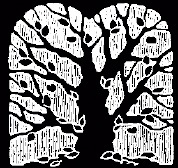While the nation following 1929 went into a tailspin, B’er Chayim merely leveled off to the solid foundation of a sound, healthy religious life. A newly organized Brotherhood furnished the impetus for additional work, not the least of which was the creation and development of the Community Forum. The forum brought to Cumberland outstanding speakers and added to the cultural life of the community and surrounding areas, and continued the good name of B’er Chayim and its membership in the favorable attention of the community. At the time, the treasurer listed fifty family members, one single member, and eight women members. The Rabbi began to conduct services over the radio, and lectured in other churches, civic clubs and schools.
Some forty children were now attending the religious school, which was adapted to the plans and curriculum suggested by the Union, including a cradle roll department and a parent study group. The celebration of the Temple’s 85th anniversary in 1938 was preceded by a complete beautification of the Temple building, exterior as well as interior.
It was at this time that the Congregation brought into being a Jewish Community Chest. Previously, every Jewish charitable and religious organization desiring contributions sent its representative to Cumberland to carry on a small yet intensive drive for funds. The Jewish Community Chest accepted contributions once yearly in a campaign of its own and distributed the funds raised to those organizations, which its budget committee thought proper. It was this organization that took the leadership role, during World War II, in raising funds for overseas as well as local and national needs, and increased charitable giving from less than $10,000.00 yearly to a maximum of more than $50,000.00.
During this period, too, the Union of American Hebrew Congregations became more active in all areas and Cumberland kept pace with the broadening scope of Reform Judaism, such as the pension plan for Rabbis which was joined at its inception.
The repercussions of Fascism under Hitler and Mussolini were felt no less here than in other places. Financial and other forms of aid was furnished to those who could escape as well as those who had to remain. When the United States became an active participant in World War II, every available Jewish young man and three young women joined some branch of the Armed Forces. Harold Yankelevitz who was with the Army at Bataan, gave the supreme sacrifice for his country. All manner of work was carried out at home in the war effort, and Rabbi Samuel Sobel, who came to Cumberland in 1944, gave unselfishly of his time and energy. The work, which he began at the Newton D. Baker Hospital in Martinsburg, became one of the projects of the Sisterhood. Assistance was given to the Army Radio School at Bedford Springs. The vestry rooms were made available to the Red Cross and other organizations in their patriotic work. But Rabbi Sobel was not content and when he asked permission for leave to become a Chaplain, the Congregation could do no less than accede to his wishes.
The war years and the post-war period had awakened a feeling of kinship with co-religionists of all lands, and energies were directed to the problems of the period. The constant work that in the past had been put into keeping up the Temple plant had been diverted. But this lack was called forcibly to mind when Rabbi Feuer accepted the pulpit and the Congregation found that because of the housing shortage he and his family would have to reside temporarily in the Temple House.


